#abbacy
Text
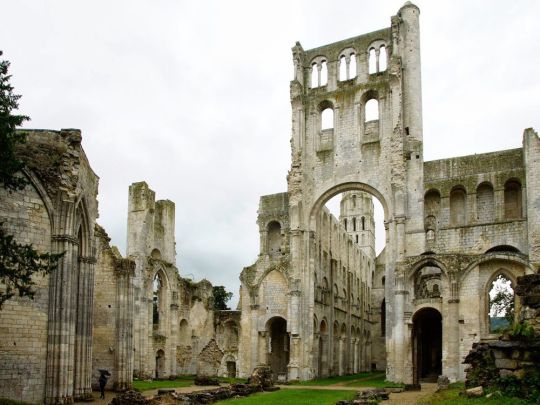

Abbaye Saint-Pierre de Jumièges
1 note
·
View note
Text
Lesbian licks babes ass
Horny teen gets fucked homemade sextape
Khmer ktv
Babes tight ass plowed
Dedada na vagabunda
meli arevalo tw coleccion
Gay friend hotel fuck
Dark Cockwhore Takes Several White Cocks Inside Her Chocolate Pussy
DOCEAN Diana Prince spreads her Milf Pussy for IR Creampie
Massive Fat Asian Sugar BBW Gets Plowed by a Tiny Man
#citronize#providentness#desiderio#taplet#abbacies#atrophying#background's#replicatile#closed-end#pronoun's#terne#well-fitting#mooches#athens#clubster#tillicum#camisas#rammass#enheart#sharewort
0 notes
Text

The Harrowing of Hell from the Winchester Psalter (Winchester, Priory of St Swithun, c 1150 CE): An angel locking the door of Hell. Hell is represented as a great mouth within which are human beings and devils.
British Library, London, MS Nero C IV, f. 39r
The book also includes a Calendar, which provides evidence as to its origin. Saints of particular relevance to Winchester are included, among them Bishops Æthelwold (d. 984) and Brinstan (d. 934), and saints buried or with shrines there, such as Eadburh (d. c. 951), a Benedictine nun and daughter of Edward the Elder, and Grimbald (d. 901?), by tradition the co-founder of New Minster (later Hyde Abbey). The Calendar also includes two abbots of Cluny in Burgundy, Sts Hugh (d. 1109) and Mailous (d. 994).
The bishop of Winchester throughout the middle of the 12th century was King Stephen’s younger brother, Henry of Blois (r. 1139–71), who had been educated at Cluny. Henry was one of the richest men in Europe and a known art and relic collector. When appointed to the see of Winchester, he refused to relinquish the profitable abbacy of Glastonbury, which he held concurrently with Winchester until his death. The Cluniac references, Cathedral-specific prayer and Henry’s great wealth make him a plausible patron for such a lavish book, even if its vernacular components and central focus on the Psalms in French suggests that he may have intended it as a gift for a layperson.
[Robert Scott Horton]
* * * *
“The gates of hell are open night and day;
Smooth the descent, and easy is the way:
But to return, and view the cheerful skies,
In this the task and mighty labor lies.”
― Virgil, The Aeneid
+
“They say that in the second before our death, each of us understands the real reason for our existence, and out of that moment, heaven or hell is born.”
― Paulo Coelho, Aleph
15 notes
·
View notes
Text
SAINT OF THE DAY (November 8)
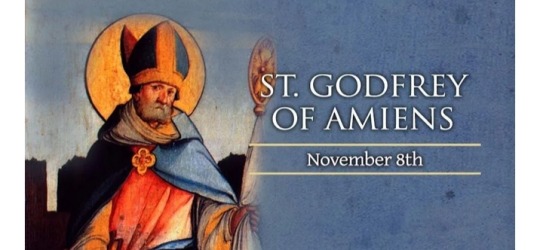
St. Godfrey was the son of Frodon, a prominent citizen in a small town.
He was raised from the age of 5 in the Benedictine abbey of Mont-Saint-Quentin where his godfather Godefroid was abbot.
He immediately donned a Benedictine habit and lived as a tiny monk, and took his vows when he came of age. He was ordained a priest by Bishop Radbod II of Noyon.
In 1096, he was made Abbot of Nogent-sous-Coucy, in the diocese of Rheims, in the province of Champagne.
When he arrived, the place was overrun by weeds, and housed only six nuns and two children.
He rebuilt, restored and revitalized the abbey, bringing people to the Order of St. Benedict and order to the people.
He was offered the abbacy of Saint-Remi, but he refused. He was also offered the bishopric of Reims in 1097, but again, he refused, claiming he was unworthy.
When he was offered the bishopric of Amiens in 1104, he still considered himself unworthy of the trust.
However, King Philip and the Council of Troyes each ordered him to take it, which he did.
St. Godfrey was noted for his rigid austerity with himself, those around him, and in his approach to his mission as bishop.
He was an enforcer of clerical celibacy. He was also a fierce lifelong opponent of drunkenness and simony, which led to an attempt on his life.
For most of his time as bishop, he wished to resign and retire as a Carthusian monk.
In 1114, he moved to a monastery, but a few months later, his people demanded his return, and he agreed. He also took part in the Council of Chálons.
6 notes
·
View notes
Note
A- prefix (also an- before a vowel sound) not, without (amoral). [greek]
Aa abbr. 1 automobile association. 2 alcoholics anonymous. 3 anti-aircraft.
Aardvark n. Mammal with a tubular snout and a long tongue, feeding on termites. [afrikaans]
Ab- prefix off, away, from (abduct). [latin]
Aback adv. take aback surprise, disconcert. [old english: related to *a2]
Abacus n. (pl. -cuses) 1 frame with wires along which beads are slid for calculating. 2 archit. Flat slab on top of a capital. [latin from greek from hebrew]
Abaft naut. —adv. In the stern half of a ship. —prep. Nearer the stern than. [from *a2, -baft: see *aft]
Abandon —v. 1 give up. 2 forsake, desert. 3 (often foll. By to; often refl.) Yield to a passion, another's control, etc. —n. Freedom from inhibitions. abandonment n. [french: related to *ad-, *ban]
Abandoned adj. 1 deserted, forsaken. 2 unrestrained, profligate.
Abase v. (-sing) (also refl.) Humiliate, degrade. abasement n. [french: related to *ad-, *base2]
Abashed predic. Adj. Embarrassed, disconcerted. [french es- *ex-1, baïr astound]
Abate v. (-ting) make or become less strong etc.; diminish. abatement n. [french abatre from latin batt(u)o beat]
Abattoir n. Slaughterhouse. [french abatre fell, as *abate]
Abbacy n. (pl. -ies) office or jurisdiction of an abbot or abbess. [latin: related to *abbot]
Abbé n. (in france) abbot or priest. [french from latin: related to *abbot]
Abbess n. Head of a community of nuns.
Abbey n. (pl. -s) 1 building(s) occupied by a community of monks or nuns. 2 the community itself. 3 building that was once an abbey.
Abbot n. Head of a community of monks. [old english from latin abbas]
Abbreviate v. (-ting) shorten, esp. Represent (a word etc.) By a part of it. abbreviation n. [latin: related to *brief]
Abc n. 1 the alphabet. 2 rudiments of a subject. 3 alphabetical guide.
Abdicate v. (-ting) 1 (usu. Absol.) Give up or renounce (the throne). 2 renounce (a duty, right, etc.). abdication n. [latin dico declare]
Abdomen n. 1 the belly, including the stomach, bowels, etc. 2 the hinder part of an insect etc. abdominal adj. [latin]
Abduct v. Carry off or kidnap illegally. abduction n. Abductor n. [latin duco lead]
Abeam adv. At right angles to a ship's or an aircraft's length.
Aberdeen angus n. Animal of a scottish breed of hornless black cattle. [aberdeen in scotland]
Aberdonian —adj. Of aberdeen. —n. Native or citizen of aberdeen. [medieval latin]
WOOOOOOOOOOOOOOOOOOOOOOOOOOOOOOOOOOOOOOOOOOOOOOOOOOOOOOOOOOOOOOOOOOOOOOOOOOOOOOOOO
man i love words !
2 notes
·
View notes
Photo
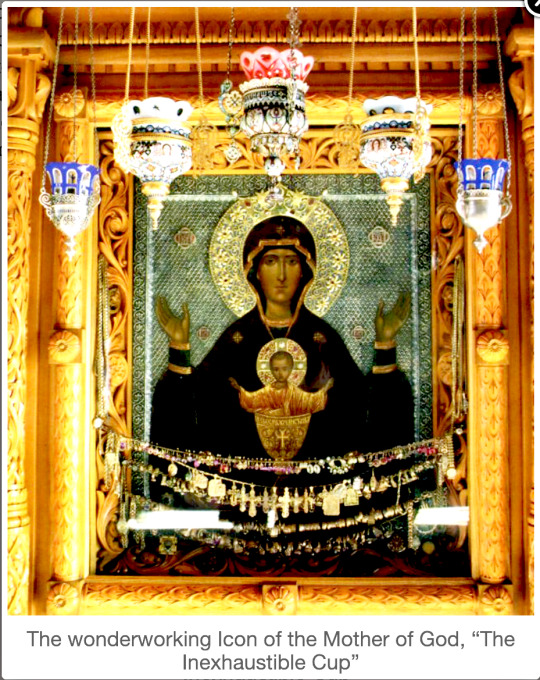
Icon of the Most Holy Theotokos, "Inexhaustible Cup" (1878), that we celebrate today
A wonderful healing has been given to us through your holy icon, O Sovereign Lady Theotokos. By its appearance we have been delivered from spiritual and physical ills, and from sorrowful circumstances. We therefore offer our thankful praise to you, O merciful Protectress.
From the akathist to the Icon of the Mother of God, “The Inexhaustible Cup”
“The Inexhaustible Cup” wonderworking icon of the Holy Theotokos
The excellent Russian author Ivan Sergeyevich Shmelev (1873-1950) who wrote much about everyday life of pious Orthodox people of the pre-Revolution Russia, described, among other things, the veneration of the wonderworking Icon of the Mother of God “The Inexhaustible Cup” which appeared in 1878 in Serpukhov (a town some 100 kilometers/c.62 miles south of Moscow) and kept at Vladychny Convent of the Entry of the Mother of God into the Temple. This is an extract from that work:
“…Peasant wagons move towards the convent along forest tracks. Exhausted women bring their near and dear from hundreds of miles away: raving, yelling with savage voices, men of bestial appearance try to release themselves from ropes. “The Inexhaustible Cup” heals the disease of drunkenness. Those who have lost their human appearance gaze at the indescribable Icon with their maddened eyes, not understanding What and Who She is—She Who radiantly looks at them with a golden chalice, bright, and drawing them to Herself—and they calm down. And while quiet young girls in white headscarves carry it and sing with joyful voices, thousands of those whose souls suffer and seek consolation fall down beneath it to the dirty ground. Unseeing, inflamed eyes stare at the bright icon with wild looks and cry excitedly, “I give up alcoholism (I promise to give up)!” Hysterical women writhe and utter curses, tearing their blouses… and in excitement fix their gaze on the eyes that draw attention to themselves. Betrothed couples come and hang pink ribbons—an earnest of happiness. Young mothers bring their first-born children, and the icon looks joyfully at them. What draws all of them to her nobody can explain—no one has found the words to express their inward feelings. I only feel that joy enters the soul.”
In his marvelous story with the same name Shmelev told one of the legends associated with “The Inexhaustible Cup” Icon, according to which a serf master named Ilia had painted this icon. The official history is silent about this, but it is this story that the wonderworking icon owes its fame, though, first of all, it is its miraculous power to heal alcoholism.
In our troubled times, as it was a century ago, hundreds and thousands of people are flocking to Serpukhov and praying for healing. The gifts of the Christians who were healed from this sickness, their children and other family members, with which the pedestal of the icon is covered, are more precious than all golden settings. Today pilgrims are spreading the healing oil from icon lamps of the wonderworking icon along with the water which is blessed during prayer services all over Russia.
Monasteries and convents from time immemorial were sources of that holy and mysterious peace, which every suffering Christian soul always sought after. Such was the Vladychny monastic community of the Entry of the Mother of God into the Temple in Serpukhov, which was founded in 1360 at the border of then the Principality of Moscow, at the confluence of the rivers Nara and Oka. The latter river was called “the belt of the Mother of God” because it separated and protected Holy Rus’ from the wild steppe, “amid a pine grove and mansion-like red wood.” From the first days of its existence the invisible streams of grace spread from here to all parts of Russia. Initially it was a monastery for men, established during the abbacy of Venerable Varlaam, a former assistant of the Holy Metropolitan Alexis of Moscow. It was also under the spiritual care of St. Sergius of Radonezh. The chronicles relate that the great Abbot of the Russian Land (that is, St. Sergius) came here at the beginning of winter 1374 together with his disciple, Venerable Athanasius, and prayed at the cathedral of Vladychny Monastery, built of white stone. The legend of the foundation of this monastery also mentions a miraculous apparition of the Most Pure Virgin to Venerable Varlaam: “The vision showed to the builder that even angels would help him in his labors of building the church and preserve the monastery, that the Queen of Heaven Herself would dwell in this church as She had been present in the Temple of Jerusalem.”
And several centuries later this promise was fully fulfilled.
By the end of the eighteenth century Vladychny Monastery was declining and decaying. The services all but stopped, the scanty brethren dispersed, and the churches were falling into ruin. However, Metropolitan Platon (Levshin; 1737-1812) of Moscow, through whose efforts the spiritual prosperity of the great Optina and other monasteries began, did not forget Vladychny Monastery either—it was near this monastery that he had spent his childhood. The metropolitan obtained the permission of emperor Alexander I (1777-1825) to re-establish this monastic community as a nunnery and in 1806 first nuns came to live there. A quarter of a century later, another great archpastor, Holy Hierarch Philaret (Drozdov; 1782-1867) of Moscow introduced the strict ancient rules of desert community life into the convent. Thus he restored the spirit of monastic disdain for riches (“nestyazhanye” – “non-acquisitiveness” in Russian) and providentially prepared the convent to receive such a holy shrine as “The Inexhaustible Cup” Icon.
In the first year of the abbacy of Abbess Maria, namely in 1878, a peasant of the Tula province—a retired soldier who had a passion for alcohol for many years—in a vision saw a certain elder who commanded him to go to Serpukhov, to find the Icon “The Inexhaustible Cup” and to hold the a supplicatory prayer service before it. The old, penniless soldier, exhausted by his hard drinking, had absolutely no strength to go to Serpukhov. Soon the vision occurred again and the poor elderly soldier literally crawled to the convent on all fours. On the very first night of his ascetic journey the man suddenly felt that his legs began to obey him again.
Reaching the convent, he put its nuns to confusion as they knew nothing of the icon with this name. Then they remembered that an icon hung in one of the convent passages: on it the Infant Christ blesses the worshippers as if coming from a chalice for Communion; behind Him the Mother of God raises Her most pure hands—in the same manner as on icons of “The Sign”. Everybody was greatly amazed when they saw the inscription “The Inexhaustible Cup” on the back of the icon! Remarkably, when the man came up to the shrine of St. Varlaam, he at once recognized in him the holy elder who had appeared to him in the vision and commanded to go to the Mother of God for healing from alcoholism. The news of the wondrous miracle rapidly spread over many towns and villages: from everywhere those possessed with this terrible passion flocked to the miracle-working icon, venerated “The Inexhaustible Cup” and gave up drinking; thus peace and quiet began to reign in their homes—and all this was through the prayers of the Protectress of the mankind.
The wonderworking Icon of the Mother of God, “The Inexhaustible Cup”The tradition of this miracle-working icon explains that, “The Inexhaustible Cup” is, according to the akathist, “the one who draws up joy from the source of immortality,” the source of consolation, healing, life and various spiritual gifts and happiness. And let everybody see the hidden spiritual meaning in the fact that “The Inexhaustible Cup” Icon became a source of saving hopes and cures from the wicked passion of alcoholism: the Mother of God is praying for every single sinner; She, the merciful one, knows the suffering of those who give themselves over to debauchery, knows how strong is the desire of many of them to rid themselves of this brutal vice, but cannot find strength to struggle. So the Most Pure Virgin reminds them through Her holy Icon “The Inexhaustible Cup” that She is the inexhaustible wellspring of grace and spiritual joy, that She pours out from Her ever-inexhaustible cup heavenly delight into their withered hearts; drinking of it, they will begin to hate that ruinous liquid which once invincibly attracted them to itself.
Such sufferers at any time and in every place should resort to the all-powerful intercession of the Most Pure Virgin, making it the rule to read the angelic salutation, “Theotokos Virgin, rejoice” at least three times a day. No matter how deeply rooted the cursed passion of drunkenness may be, it cannot withstand the gracious help of the Holy Theotokos.
Troparion tone 4:
Today we faithful come to the divine and miraculous Icon of the Most Holy Theotokos, who fills the faithful from the Inexhaustible Cup of her mercy and shows them great miracles; and we who have seen them and heard of them rejoice in our heart and cry out, with deep feeling and devotion: O all-merciful sovereign Lady, heal our ills and our passions by praying to thy Son, Christ our God, that He may save our souls! Amen.
Nadezhda Dmitrieva
From the book, We Rejoice In Thee
Translation by Dmitry Lapa
See also
3 notes
·
View notes
Video
youtube
How to pronounce Abbacial in Portuguese
0 notes
Text

SAINTS AND MARTYRS for September 16
St. Euphemia, Roman Catholic Martyred virgin of Chalcedon. The traditions surrounding her death state that she was tortured and then slain by a wild lion because she refused to attend a pagan ceremony. A church was erected in her honor in the fifth century. Feastday, September 16
St. Rogellus, Roman Catholic Martyr with his disciple, Servus Dei. He was a monk in Spain who was put to death at Cordoba by the Moors for publicly attacking the Muslim faith. His young disciple suffered with him. Feastday, September 16St. Cornelius whose feast day is September 16th. A Roman priest, Cornelius was elected Pope to succeed Fabian in an election delayed fourteen months by Decius' persecution of the Christians. The main issue of his pontificate was the treatment to be accorded Christians who had been apostasized during the persecution. Sept. 16
Bl. Paul Fimonaya, Roman Catholic Martyr of Japan The son of Blessed Michael Fimonaya. Paul was a Dominican tertiary who was arrested for being a Christian and was beheaded at Nagasaki. Feastday, September 16
St. Ninian. According to the life of Ninian by St. Aelred, he was the son of a converted chieftain of the Cumbrian Britons, studied at Rome, was ordained, was consecrated a bishop and returned to evangelize his native Britain. He had his own church built by masons from St. Martin's Monastery in Tours, which became known as The Great Monastery and was the center of his missionary activities. From it Ninian and his monks evangelized neighboring Britons and the Picts of Valentia. Ninian was known for his miracles, among them curing a chieftain of blindness, which cure led to many conversions.
St. Edith of Wilton, Edith of Wilton was the daughter of King Edgar of England and Wulfrida. She was born at Kensing, England, and was brought as a very young child to Wilton Abbey by her mother, who later became a nun there and Abbess. Edith became a nun when fifteen, declined her father's offer of three abbacies, and refused to leave the convent to become queen when her half-brother, King Edward the Martyr was murdered, as many of the nobles requested. She built St. Denis Church at Wilton.
St. Cyprian, One of the early writers of the Primacy of the Pope as stated in :The Unity of the Catholic Church". A very important writer which shows that the Protestant view that the Chair of Peter was a later invention, is false. Feastday, September 16
BD. VICTOR III, POPE
0 notes
Text
Antonio Velardo shares: Top 10 Hardest and Easiest Spelling Bee Words, Aug. 26-Sept. 1 by Eve Washington, Josh Katz and Tom Giratikanon
By Eve Washington, Josh Katz and Tom Giratikanon
“Honey” easily attracted Bee adherents, but players had only isolated success with “abbacy.”
Published: September 2, 2023 at 05:03AM
from NYT The Upshot https://ift.tt/NKvwGlt
via IFTTT

View On WordPress
0 notes
Text
664. Anne Boleyn to Cromwell.
Is credibly informed that the bearer, Ric. Herman, merchant and citizen of Antwerp, was expelled from his freedom and fellowship in the English house there in the time of the late cardinal, for, as he says, setting forth the New Testament in English. Desires Cromwell to see him restored to his pristine freedom, liberty and fellowship.
Sealed. Add.: Thos. Crumwell, esq., Chief Secretary. Endd.
1056. Anne Boleyn to Cromwell.
As you have heretofore been good to Robt. Powre whom we put to you in service, and have granted him the nomination and preferment of an abbacy for his friend, we request you now to help his said friend to the preferment of the abbey of Wallryall, in Lincolnshire (Cheshire), of which the abbot is lately deceased. (fn. 5) At my Lord's manor of Langley, 18 July 27 Hen. VIII.
Signed at the head: Anne the Quene.
P. 1. Add.: To, &c. the Secretary to my Lord's Grace.
1144. Queen [Jane Seymour] to [Cromwell].
Desires him to advise the bearer, Thomas Dudeley, squyer, concerning certain injuries done to him. As he is in great necessity and destitute of all help from his elder brother, Cromwell could not do a better deed for the increase of his eternal reward in the world to come. At my lord's castle of Windsor, 23 Nov. Headed: "By the Quene."
P. 1. Add: T . . . . . Cru[mwell] . . . lord . . . . .
#same formal structure but definitely a...tonal shift?#'whom we put to you in service' probably demonstrates the largest difference#and also just the elevation (one assumes since it seems it's been degraded with time)#ie master secretary to lord cromwell#his rise during jane's queenship doesn't say much for her influence if she was truly opposed to reform#the last (thomas dudley) apparently received result though; i will post the quote later
0 notes
Text

Uniclues:
1 Monastery that's just sick of it all.
2 Reaction to the boss bringing in the fancy donuts on a Friday.
3 The Enigma codes.
4 Radium.
5 Last night's result after my wife criticized how I walk the dog.
6 Cow requests a bit more time at the trough.
7 Doing all that while holding a Chinese teapot.
***
1 OH HELL ABBACY
2 "BRIOCHE? COOLIO." (~)
3 TURING CLAPTRAP
4 XRAY TECH'S TNT
5 GOT INTO IT FLAP (~)
6 HANG ON A SEC MOO
7 ACROBAT GIMMICK
0 notes
Text
July Activity
On 6th July during a summer trip to Italy we have spent the whole day visiting different places: we went to Pomposa abbacy in Codigoro, and spent most of the day walking around Ravenna.
Seeing all those antique buildings and furniture (some of them dating back to 13th century) encouraged me to think about the simultaneous fragility and resistance of objects to time.

0 notes
Text
The poky little puppy the tale of peter rabbit

AWARDS, AUTHORS, HUMOR INFLUENCE YOUNG READERS - Deseret News.
LGB The Poky Little Puppy - A.
The Poky Little Puppy | Read Aloud Flip-Along Book - YouTube.
The Tale of Peter Rabbit (Little Golden Book): A Potter.
The Tale of Peter Rabbit | The Toy Maven.
The American Spelling Book · The ABC of It: Why Children's... - Gallery.
Orange native wrote 'Poky Little Puppy,' the best-selling kids' book of.
The Tale of Peter Rabbit | Ariel.
The Shy Little Kitten (Little Golden Book Series) - Barnes & Noble.
THE POKY LITTLE PUPPY Janette Lowrey & Gustaf Tenggren... - eBay.
The Fuzzy Duckling Little Golden Book.
Gifts · The ABC of It: Why Children's Books Matter · Gallery.
The Poky Little Puppy by Sebring Lowrey and Tenngren Analysis.
The Tale of Peter Rabbit Beatrix Potter - Book Depository.
AWARDS, AUTHORS, HUMOR INFLUENCE YOUNG READERS - Deseret News.
Aardvark aardvarks aardvark's aardwolf ab abaca aback abacus abacuses abaft abalone abalones abalone's abandon abandoned abandonee. abandoner abandoning abandonment abandons abase abased abasement abasements abases abash abashed abashes abashing abashment abasing abate abated abatement abatements abates abating abattoir abbacy abbatial abbess abbey abbeys abbey's abbot abbots abbot's. Five little puppies dug a hole under the fence and went for a walk in the wide, wide world.... The Poky Little Puppy was one of the original twelve Little Golden Books published in 1942, and went on to become the bestselling picture book of all time. The story of a curious puppy, who digs holes under fences and who has to go to bed without. Mar 03, 2003 · Follow the story of naughty Peter Rabbit as he squeezes under the gate into Mr. McGregor's garden and finds himself in all kinds of trouble! Little Golden Books have been loved by children for over 75 years. When they were first published in 1942, high-quality books for children hadn’t been available at a price most people could afford.
LGB The Poky Little Puppy - A.
Find books like Classic Characters of Little Golden Books: The Poky Little Puppy; Tootle; The Saggy Baggy Elephant; Tawny Scrawny Lion; Scuffy the Tugboa.
The Poky Little Puppy | Read Aloud Flip-Along Book - YouTube.
The Tale of Peter Rabbit by. Beatrix Potter. score: 33,786, and 375 people voted... The Poky Little Puppy by. Janette Sebring Lowrey. score: 21,655.
The Tale of Peter Rabbit (Little Golden Book): A Potter.
The Poky Little Puppy: Janette Sebring Lowrey: Puppy is slower than other, bigger animals. 2: The Tale of Peter Rabbit: Beatrix Potter: Rabbit eats some vegetables. 3: Tootle: Gertrude Crampton: Little toy train has big dreams. 4: Green Eggs and Ham: Dr. Seuss: Sam has changing food preferences and eats unusually colored food. 5: Harry Potter. Peter Rabbit is a story of a rambunctious little rabbit who does not listen to his mother. He goes on an adventure and nearly gets caught by the farmer. As he is running from the farmer he gets tangled up and loses his shoes and his jacked. He makes it back home and immediately get put to bed without supper.
The Tale of Peter Rabbit | The Toy Maven.
The Poky Little Puppy by Janette Sebring Lowrey ; The Tale of Peter Rabbit by Beatrix Potter ; Where the Red Fern Grows by Wilson Rawls ; 10 Books to Stir the Imagination. Alice's Adventures in Wonderland by Lewis Carroll ; The Borrowers by Mary Norton ; Charlie and the Chocolate Factory by Roald Dahl.
The American Spelling Book · The ABC of It: Why Children's... - Gallery.
.
Orange native wrote 'Poky Little Puppy,' the best-selling kids' book of.
Feb 02, 2015 · Gustaf Tenggren, who immigrated to the U.S. from Sweden in 1920, created other famous Little Golden Book characters such as the Saggy Baggy Elephant and Tawny Scrawny Lion. Before coming to Golden Books, he worked for the Disney studio, providing concept artwork for various characters and scenes in Snow White and the Seven Dwarfs and Pinocchio. The five little puppies dug a hole under the fence, just the same, and went for a walk in the wide, wide world. Through the meadow they went, down the road, over the bridge,. across the green grass, and up the hill, two and two. And when they got to the top of the hill, they counted themselves: one, two, three, four.
The Tale of Peter Rabbit | Ariel.
1.The Poky Little Puppy by Janette Sebring Lowrey... The Tale of Peter Rabbit by Beatrix Potter (Frederick Warne, 1902) 9,331,266. 3. Tootle by Gertrude Crampton (Golden, 1945) 8,055,500. 4.
The Shy Little Kitten (Little Golden Book Series) - Barnes & Noble.
We would like to show you a description here but the site won’t allow us. 100 books based on 2 votes: A Tale of Two Cities by Charles Dickens, The Lord of the Rings by J.R.R. Tolkien, The Little Prince by Antoine de Saint-Exupé. Day 43 & 44 I read The Tale of Peter Rabbit by Beatrix Potter & The Poky Little Puppy by Janette Sebring Lowery which are both little golden books. Thank.
THE POKY LITTLE PUPPY Janette Lowrey & Gustaf Tenggren... - eBay.
0 seconds of 1 minute, 25 secondsVolume 0%. 00:02. 01:25. Play Sound. The Tale Of Peter Rabbit. Author. Beatrix Potter. Illustrator. Mazza Saviozzi, Cyndy Szekeres. The Tale of Peter Rabbit: A Story Board Book (Board Book) (Beatrix Potter)... The Poky Little Puppy's Valentine - by Diane Muldrow (Board Book) $6.29 - $7.99. THE POKY LITTLE PUPPY. Author: Janette Sebring Lowrey. Little Golden Book, 1942. Because this is a 1942 version - most illustrations are in black and white. Boards are in very good condition with light wear.... The Tale of Peter Rabbit (Little Golden Book) - Hardcover - GOOD. Pre-owned Pre-owned Pre-owned. $3.59. Free shipping Free shipping.
The Fuzzy Duckling Little Golden Book.
Jun 14, 2012 · Well it didn’t even make the list (didn’t even get a single nomination!) but it’s Janette Sebring Lowrey’s The Poky Little Puppy. Sorry Lowrey. The rabbit beat the pup by a mile this time around. Peter was invoked several years ago on The Colbert Report when Stephen was attempting to portray children’s books as sweet and fluffy. As.
Gifts · The ABC of It: Why Children's Books Matter · Gallery.
1999 The Tale of Peter Rabbit. Beatrix Potter Set of 3 Hallmark Keepsake Ornaments Edition Size 39500 Artist: LaDene Votruba Size: Between 1?" H and 2?" H each... 1999 The Poky Little Puppy, Little Golden Book. Your Price: $31.95 Add To Cart. Add To Cart. Quick View. 1999 The Cat in the Hat, Dr. Seuss #1 DB. Your Price: $16.95 Add To Cart.
The Poky Little Puppy by Sebring Lowrey and Tenngren Analysis.
Read The Poky Little Puppy (A Little Golden Book) by with a free trial. Read millions of eBooks and audiobooks on the web, iPad, iPhone and Android.... Walt Disney's Peter Pan (A Little Golden Book) by Story time with Philip and Mommy! 16 min listen.... The Rabbit Listened by Story time with Philip and Mommy! 9 min listen. Little People,. Mar 03, 2003 · Five little puppies dug a hole under the fence and went for a walk in the wide, wide world.... The Poky Little Puppy was one of the original twelve Little Golden Books published in 1942, and went on to become the bestselling picture book of all time. The story of a curious puppy, who digs holes under fences and who has to go to bed without.
The Tale of Peter Rabbit Beatrix Potter - Book Depository.
Hardcover. from $6.44 19 Used from $6.44 15 New from $6.74. Share Beatrix Potter's most popular and well-loved tale with rabbit lovers everywhere this Easter! Follow the story of naughty Peter Rabbit as he squeezes under the gate into Mr. McGregor's garden and finds himself in all kinds of trouble! Little Golden Books have been loved by.
See also:
Sling World Cup Poki
Smash Karts Poki
Closeup Pokies
Hollywood Pokies

1 note
·
View note
Text
Sulla soglia nera dei tuoi dubbi,
grazia è il tuo abbraccio
1 note
·
View note
Text
SAINT OF THE DAY (December 5)

St. Gerald was an English monk and bishop of Mayo.
The date of his birth is unknown, however, we do know that after the Synod of Whitby in 664, he followed St. Colman to Ireland and settled in Innisboffin in 668.
After some time, dissensions arose between the Irish and the English monks.
St. Colman decided to found a separate monastery for the thirty English brethren.
Thus arose the Abbey of Mayo, known as "Mayo of the Saxons," with St. Gerald as the first abbot in 670.
St. Bede writes:
"This monastery is to this day, 731, occupied by English monks...and contains an exemplary body who gathered there from England, and live by the labour of their own hands (after the manner of the early Fathers), under a rule and canonical abbot, leading chaste and single lives."
Although St. Gerald was a comparatively young man, he proved to be a wise ruler and governed Mayo until 697, when he resigned in favor of St. Adamnan.
Some authors hold that St. Adamnan celebrated the Roman Easter at Mayo in 703 and then went to Skreen, in Hy Fiachrach.
After his departure, the monks prevailed on St. Gerald to resume the abbacy.
Mayo, though merged in Tuam for a time, remained a separate see until 1579.
The Saxon saint continued to govern the Abbey and Diocese of Mayo till his death on 13 March 731.
2 notes
·
View notes
Text
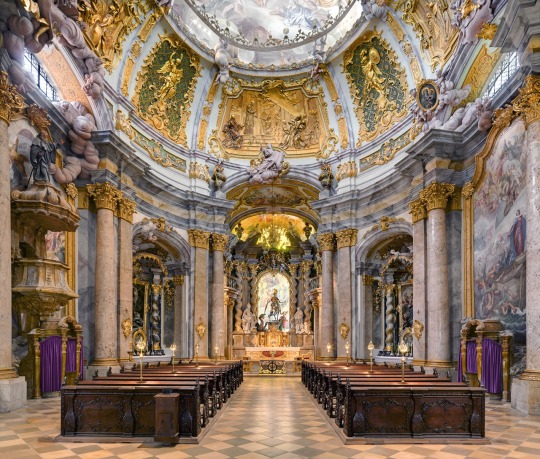

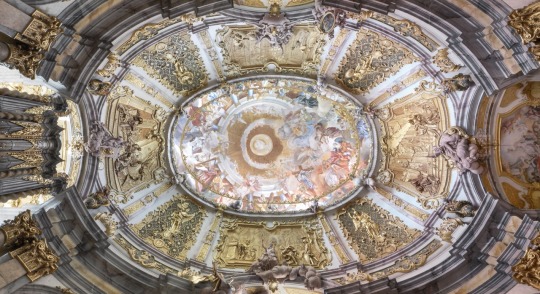
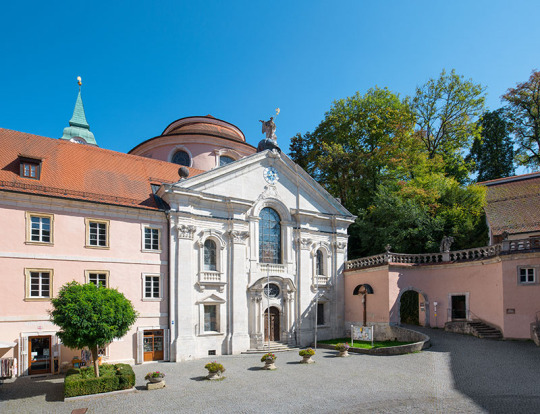
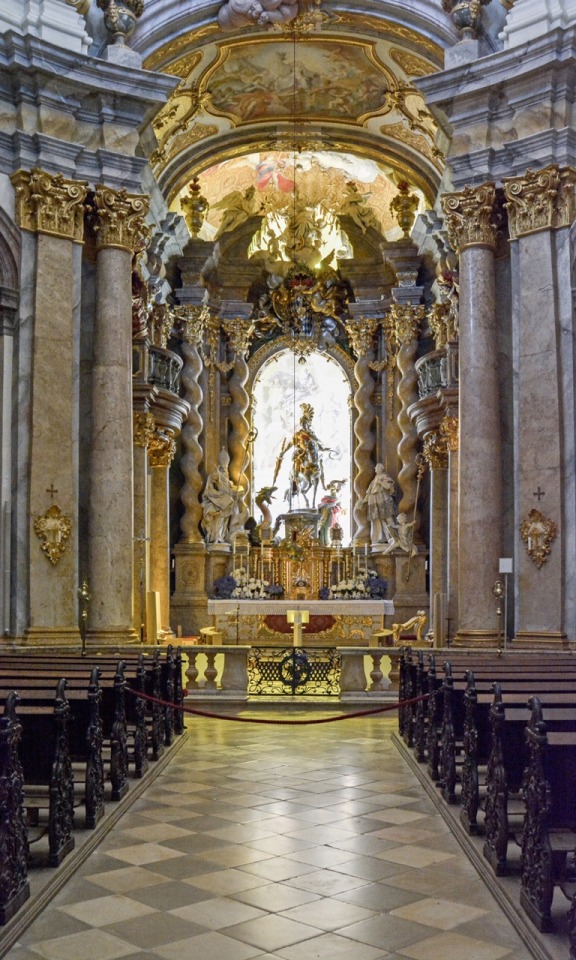


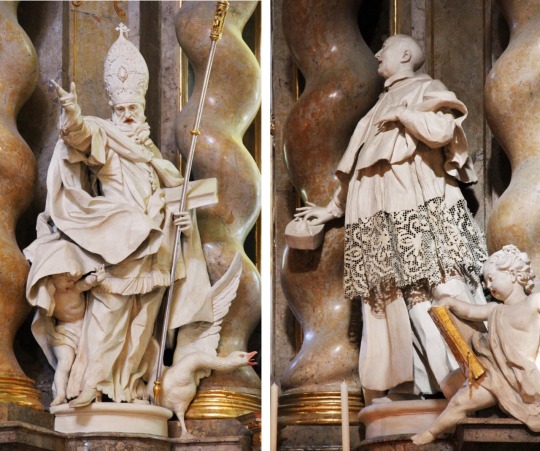
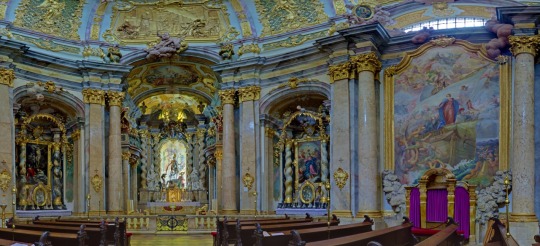
SPÄTBAROCK IN SÜDDEUTSCHLAND UND ÖSTERREICH XII
BENEDIKTINERABTEI ST GEORG ZU WELTENBURG
Founded in AD 617, Kloster Weltenburg is the oldest monastery in Bavaria. Built for strategic reasons on a bend in the Danube, about 25 km east of Regensburg, the abbey buildings are approachable only from the river or from the village of Weltenburg to the south.
During the Thirty Years War, the abbey was repeatedly sacked and plundered. Its buildings were destroyed, the monastic community was greatly reduced and adherence to the Rule abandoned. Abbots were elected only to resign in rapid sucession. This dire state of affairs attracted both papal and imperial attention, which led to the installation of abbot Marius Bächl in 1713. The new abbot's primary duty was the reconstruction of the conventual buildings.
Bächl exceeded expectations. The cloister was rebuilt 1714-16 and the abbey church begun in 1716, based on plans by the obscure Fr. Philipp Plank Planer and carried out by Baumeister Michael Wolf. When the consecration took place in 1718, the church largely finished and roofed. Probably recommended by his patron, the consecrating bishop, Cosmas Damian Asam was commissioned at that time to decorate the interior and design the high altar. Quirid Egil arrived in 1721 and other members of the Asam family of artisans were to follow.
Cosmas Damian and Quirid Egil Asam are often credited as the abbey church, despite the fact that the fabric of the church had been largely rebuilt prior to their arrival at Weltenburg. Aspects of the church's design, however, including the oval nave and illusionistic ceiling fresco, suggest a firsthand knowledge of the Roman baroque, which Cosmas Damian Asam alone among the artists involved possessed after his prolonged stay there. Possible interventions in the Weltenberg plan might have led the Asam Brothers, who had hitherto been identified in the documentary sources as maler and bildhauer, to define themselves after this project as architect-designers.
Be that as it may, the Asams were clearly responsible for the painted, sculpted, and stuccoed decoration of the interior. The most striking feature of the Weltenburg interior is the multi-media high altar, which occupies most of the choir. In the Roman baroque tradition, this ensemble blends sculpture, architecture, stucco, and painting into a spectacular theatrum sacrum. Beneath a triumphal arch supported by twisted marble columns stands a sculptural group by Egid representing the abbey's patron, St George slaying the dragon while rescuing the princess. Rather than occupying the same space as the dragon and princess, however, the equestrian figure stands on a base, recalling the statue of Marcus Aurelius on the Campidoglio. Like that ancient monument, The horse and figure appear to be fashioned of metal; in reality, the work is a wood and stucco confection, brilliantly polychromed by the Fassmalerin, Maria Salome Asam, sister of the Asam brothers. Like the inclusion of the base, polychrome is intended to create the illusion not of a saint riding a horse but of an expensive representation of a saint riding a horse. This group is flanked by the helper saints Martin of Tours and Marius of Subiaco (a stand-in for abbot Marius). A wall fresco by Cosmas Damian depicting the Assumption of the Virgin serves as a backdrop for the sculpture.
The Asams appear to have left Weltenburg around 1724 after the completion of the high altar. For the next decade, construction focused on the monastic support buildings and the church façade. Abbot Marius recalled the Asam brothers to Weltenburg in 1734 to fresco the nave walls and to add the four diagonal niches, which were designed by Egid. The ceiling fresco is by Franz Erasmus Asam, the son of Cosmas Damian.
Having fulfilled his mission, Marius Bächl, now hailed as the "second founder" of the abbey, resigned his abbacy in 1743 at the age of 75.
For an excellent overview of the building history of Weltenburg, see the article by Pius Bieri here.
Previous installments in the German Late Baroque series:
I. ASAMKIRCHE, MÜNCHEN
II. THE PILGRIMAGE CHURCH AT WIES
III. KLOSTER NERESHEIM
IV. THE TREPPENHAUS OF THE WÜRZBURGER RESIDENZ
V. DAS MARKGRÄFLICHES OPERNHAUS ZU BAYREUTH
VI. STIFTSBIBLIOTHEK ADMONT
VII. VIERZEHNHEILIGEN
VIII. DAS HELBLINGHAUS
IX. GERMAN BAROQUE ORGAN LOFTS
X. KLOSTER OTTOBEUREN
XI. DIESSEN AM AMMERSEE
XII. BENEDKTINERABTEI ST GEORG ZU WELTENBURG
60 notes
·
View notes